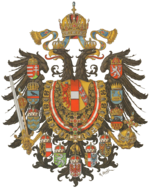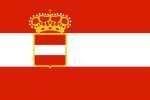- Military of Austria-Hungary
-
Military of Austria-Hungary
Österreichisch-Ungarisches Militärwesen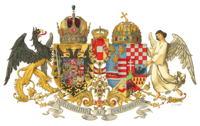
Arms of the Dual MonarchyFounded 1867 Disbanded 1918 Service branches k. u. k. Armee
k.k. Landwehr
k.u. Landwehr
k. u. k. Luftfahrtruppen
Kaiserliche und Königliche KriegsmarineHeadquarters Vienna Leadership Commander-in-Chief Emperor Karl I(final) Minister of War Rudolf Stöger-Steiner von Steinstätten (final) Chief of staff Hermann Kövess von Kövessháza (final) Manpower Military age 17 years of age Available for
military service13,402,788 (1914 est.), age 15–49 Fit for
military service9,031,046 (1914 est.), age 15–49 Reaching military
age annually423,809 (1914 est.) Active personnel 2,500,000 (1914) Deployed personnel 7,800,000 (1914–1918) Industry Domestic suppliers  Skoda
Skoda
 Steyr Mannlicher
Steyr MannlicherRelated articles History Austrian Empire
Austrian Army
Military history of Austria
Imperial and Royal Army during the Napoleonic Wars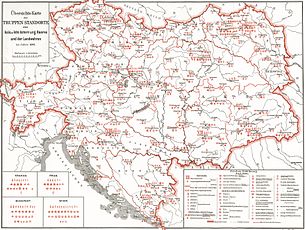 The 16 Military Districts of Austria-Hungary in 1898 (in German)
The 16 Military Districts of Austria-Hungary in 1898 (in German)
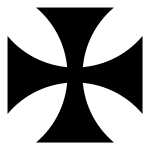 The Cross Pattee
The Cross Pattee
The Military of Austria-Hungary, comprising the Armed Forces, War Office, and intelligence organisations of the Dual Monarchy served as one of the Empire's core unifying institutions and primary instruments for defense as well as external power projection. The history of the Austro-Hungarian military begins when the Habsburgs established hereditary rule over Austrian lands in the 13th century and stretches until the fall of the Habsburgs, at the end of World War I, during which time their armies were among the largest and most significant in Europe. Though not as powerful as some of its contemporaries, the military of Austria-Hungary's scale, resources, organization, technology and training were one of the central factors determining conferral of 'great power' status on the empire for much of the 19th and early 20th centuries.
Contents
Administration and organization
The Military of Austria-Hungary was divided primarily into three primary service branches, with the navy sitting entirely independently of the other two, which to one extent or the other remained interlinked for the duration of their existence but all three of which fell within the ultimate remit of the Minister for War:
The war ministry itself served as one of the few 'common' ministries with jurisdiction throughout the Empire and over which the Imperial, as opposed to Austrian or Hungarian governments had local control. Command over large 'home' forces – the Landwehr units which served functions analogous to National Guard forces in the United States were however controlled by local Ministries of Defense in both Austria and Hungary. Within the War Ministry, the Navy enjoyed considerable autonomy through the Naval Section with its own staff and head quarters, while the Ministry itself concentrated more on quarter master and administrative functions that close operational control of its respective services.
Whilst nominal the umbrella organisation which managed the Empire's Military capabilities, the War Ministry was not responsible for not only large state militia forces during peacetime but also an array of organisations such as the Evidenzbureau, who's remit fell within the Ministry of Foreign Affairs. The organisation of units and forces amongst a plethora of different commands and bodies had the effect of instilling a number of organisational cultures, diffusing responsibility, creating competition between agencies, failing to develop inter-organisational efficiencies and meaning that no one body had overall control of all military forces below the Emperor in preparing for war.
Below the Minister for War, separate staffs and commanders-in-chief oversaw the training, planning, and operations responsibilities of their respective service branches. In terms of the Army, by 1914 it was divided amongst 16 Military Districts and comprising 325,000 active troops at all levels as well as 40,000 Austrian Lanwher and 30,000 troops of the Hungarian Honved.
The Austro-Hungarian Navy maintained a number of naval facilities in the Adriatic, most importantly that at Pola, and possessed some 3 modern Dreadnought class battleships in 1914 as well as 3 modern pre-dreadnoughts and 9 older battleships and a range of other craft including cruisers, destroyers and submarines in various states of combat readiness.
The Austro-Hungarian Airforce remained embryonic in 1914 with a few German built planes having been added to the Army balloon service in 1913, but was to see marked expansion during the early years of the war.
History and operations
Origins
The Austro-Hungarian Military was a direct descendant of the military forces of the Habsburg sections of the Holy Roman Empire from the 13th century and the successor state the was the Austrian Empire from 1804. For 200 years, Habsburg or Austrian forces had formed a bastion defending the continent against repeated Ottoman campaigns to overrun Europe with the Turks being turned back twice only after reaching the gates of Vienna in 1529 and again in 1683. Count Ernst Rüdiger von Starhemberg, commanding troops in the city, broke the siege in 1683 with the aid of German and Polish forces under the King of Poland, Jan Sobieski, then drove the Turks back into the Balkans, finally ending the Ottoman threat.
Prince Eugene of Savoy, in coordination with the Duke of Marlborough, won a series of victories over Louis XIV of France in the War of the Spanish Succession (1701–14). Wars fought with the Prussia of Frederick the Great over Silesia in 1740–48 (the War of the Austrian Succession) and 1756–63 were less successful. The monarchy's military potential during the eighteenth century was limited by the emperor's dependence on provincial Diets for recruits and tax receipts while the nobles of the imperial lands who controlled the enserfed peasantry had no fixed obligation to provide soldiers to the Habsburgs.
Austria was prominent in the coalitions that tried to contain Napoleon but was defeated in 1800, again in 1805 when Napoleon occupied Vienna after the Battle of Austerlitz, and finally after the Battle of Wagram in 1809. Austria still joined the final campaign resulting in Napoleon's defeat in 1814.
Armies displayed their loyalty to the monarchy in 1848 and 1849, suppressing the revolutionary regimes that had swept into power in Vienna, Budapest, Milan, and Prague. In 1859 Austria was provoked into war with Piedmont and its supporter, the France of Napoleon III. The Austro-Piedmontese War lasted only three months, but both sides mobilized large armies. The Austrians were defeated after bitter fighting at Magenta and Solferino, the young Emperor Franz Joseph assuming personal command during the Battle of Solferino.
Prussia established its domination over other German states by its victory over Austria in the Seven Weeks' War in 1866. The critical battle was waged at Königgrätz (Hradec Králové in the present-day Czech Republic). The Austrians armed with muzzle-loading rifles sustained 20,000 casualties and lost 20,000 prisoners. The battle overshadowed Austria's victories over Prussia's Italian allies at Custozza and in the naval Battle of Lissa (Vis) off the Dalmatian coast in which a smaller Austrian fleet of ironclads overcame the Italians by ramming them. Following the end of the Seven Weeks' War, Austria experienced fifty years of peace until World War I broke out in 1914.
In spite of their size and distinction in individual engagements, Habsburg armies of the nineteenth century had mostly known defeat in encounters with European major powers. They were often handicapped by uninspired or timid battlefield leaders. The principal cause of their failure was the that Austria allocated the lowest proportion of its revenue to its military. Various political groups continuously blocked adequate expenditures on the army. For example, the Prussian infantry, using breech-loading rifles in 1866, had four to five times the effective firepower of the Austrian infantry. The constant economizing was also reflected in the poor training of conscripts and in the quality of the notoriously underpaid company-grade officers. Tactics, based on frontal assault with fixed bayonets, were outdated. The quartermaster corps had a reputation for inefficiency and corruption.
The standing army consisted of twelve corps with 240,000 men in 1854. When mobilized it expanded to over 800,000 and was the largest army in Europe. However, the speed of mobilization and the capacity to move troops to the scene of battle was worse than that of the Prussians, who made full use of their growing rail system. As a matter of policy, conscripts were assigned to regiments far from their homes. A call-up involved slow train journeys for reservists; mobilization required eight weeks, nearly twice as long as mobilization of the Prussian army, which was organized by region.
1867–1914
The creation of Austria-Hungary under the Compromise (Ausgleich) of 1867 separated the Empire into independent Austrian and Hungarian governments. Only the army, foreign affairs, and related budgetary matters remained with the emperor, who held supreme command of all forces in time of war. A new army law decreed universal three-year conscription followed by a ten-year reserve obligation. In practice, only about one in five of those liable to service were called up, and many were sent on leave after two years. The army of Austria-Hungary has been described as a state within a state. In an empire of ten nationalities and five religions, marked by ethnic conflict and sharp political and economic divisions, the army formed the only real bond among the emperor's subjects and the sole instrument through which loyalty to him could find expression.
Nevertheless, Austria-Hungary gave the impression of being a highly militarized nation. According to British historian Edward Crankshaw who noted that not only the emperor but most males in high society never wore civilian clothes except when hunting. Select regiments of the army were splendidly outfitted, but, with a few dedicated exceptions, the officers, so magnificent on the parade ground, "shrank . . . from the arbitrament of arms as from an unholy abyss."
Regiments were organized along linguistic lines, although German was the language of command. Ethnic factors did not prevent recruitment of non-German speakers to the officer corps or their regular promotion. Hungarians, Croats, Serbs, Poles, Italians, Czechs, Slovenes, and Romanians could be found in senior positions. In the more prestigious units, most field-grade officers owed their ranks to birth or wealth. As of 1900, a majority of the officer corps in the Austro-Hungarian army were native German speakers, although only one-fourth of the empire's total population was German speaking.
During the late 19th and early 20th century leading up to World War One, the Austro-Hungarian Military underwent a process of modernisation in all service branches in terms of training, equipment and doctrine, although many traditions and old-practices remained in force. As a result of the efforts chief-of-staff Montecuccoli and heir to the throne Franz Ferdinand the navy underwent considerable modernisation with the commission of a number of new units, and specifically three up-to-date battleships delivered by 1914. The army too underwent gradual and constant modernisation but maintained an unhealthy commitment to fortress-warfare as evidenced by concentration on giant artillery pieces and fortification building along the empire's eastern frontier. Although sometimes dismissed as fanciful and lacking touch with the realities confronting the forces at his disposal, as a chief of General Staff Conrad had ensured the army had remained vigilant and planning for war was at an advanced stage by 1914, although it has been argued that reorganisation and redeployment should have been sweeping in the aftermath of the Redl affair.
During the period of 1867–1914, Austro-Hungarian forces were stationed on a number of national and international assignments. Although the empire exhibited no colonial aspirations, forays abroad including the military occupation of Bosnia and Herzegovina, the Novi Pazar, the expedition to Crete and involvement in the Boxer Rebellion.
1914–1918
Main article: Austria-Hungary in the Great WarAt the start of the war, the army was divided in two, the smaller part attacked Serbia while the larger part fought against the massive Russian army. The 1914 invasion of Serbia was a disaster. By the end of the year the Austro-Hungarian Army had taken no territory and had lost 227,000 men (out of a total force of 450,000 men); see Serbian Campaign (World War I).
On the Eastern front, things started out equally badly. The Austro-Hungarian Army was defeated at the Battle of Lemberg and the mighty fort city of Przemysl was besieged (it would fall in March 1915).
In May 1915, Italy joined the Allies and attacked Austria-Hungary. The bloody but indecisive fighting on the Italian front would last for the next three and a half years. It was only this front that the Austrians proved effective in war, managing to hold back the numerically superior Italian armies in the Alps.
In the summer, the Austro-Hungarian Army, working under a unified command with the Germans, participated in the successful Gorlice–Tarnow Offensive.
Later in 1915, the Austro-Hungarian Army, in conjunction with the German and Bulgarian armies, conquered Serbia.
In 1916, the Russians focused their attacks on the Austro-Hungarian army in the Brusilov Offensive, recognizing the numerical inferiority of the Austro-Hungarian Army. The Austrian armies took massive losses (losing about 1 million men) and never recovered. The huge losses of men and material inflicted on the Russians during the offensive contributed greatly to the causes of their communist revolution of 1917. The Austro-Hungarian war effort became more and more subordinate to the direction of German planners, as it did with the standard soldiers. The Austrians saw the German army positively, but by 1916 the general belief in Germany was that they were "shackled to a corpse." Supply shortages, low morale, and the high casualty rate seriously affected the operational abilities of the army, as well as the fact the army was of multiple ethnicity, all with different race, language and customs.
The last two successes for the Austrians: the Conquest of Romania and the Caporetto Offensive, were German-assisted operations. Due to the fact that the empire had become more and more dependent on German assistance, the majority of its people, not of Hungarian or Austrian ethnicity, became aware of the empire's destabilization.
Assessment
Although performance in the initial months of the war against Serbia and Russia is often seen as poor, Austro-Hungarian forces were not helped by internal division and indecision amongst the army high command and possession by Serbian and Russian forces of highly detailed versions of Austro-Hungarian war plans. Overall during the Military's greatest deployment – World War I – and despite persistent fears of disloyalty and division amongst the Empire's many nationalities, the forces of Austria-Hungary must be seen as having performing largely competently until political demise in late 1918. Imperial forces performed with both great proficiency – the Otranto Raid, Caporetto, and the dogged defense of the Isonzo; and with appalling effect – the Galicia Campaign, the Brusilov Offensive and Vittorio Veneto; as well as at a variety of standards in between. Ultimately, and with much German support, Imperial armed forces held firm, and without much by way of large-scale defections amongst what were seen as 'suspect' elements of the population until the dying days of the war when political dissent at home led to large-scale defeats both on the front and at Sea as the war came to an close.
Legacy
Some of the traditions of the old Austro-Hungarian Army continue to be carried on in the modern Austrian Army. For example, the most famous regiment in the Bundesheer is the "Hoch und Deutschmeister Regiment", now known as Jägerregiment Wien based in "Maria Theresien Kaserne", named after Empress Maria Theresa of Austria. Many other regiments of the Bundesheer carry on traditions of the famous Austro-Hungarian regiments like "Kaiserjäger", "Rainer", etc.
Gallery
-
k.u.k. troops leaving Jerusalem, 1916
-
k.u.k. Troops in Action, World War I
-
k.u.k. Infantry Regiment march past the Emperor on the centenary of the Battle of Leipzig
-
The Imperial Guard posing at Schönbrunn
-
k.u.k. World War I Fighter Plane
-
Turrets of the SMS Tegetthoff
Further reading
- Brewer-Ward, Daniel A. The House of Habsburg: A Genealogy of the Descendants of Empress Maria Theresia. Clearfield, 1996.
- Crankshaw, Edward. The Fall of the House of Habsburg. Sphere Books Limited, London, 1970. (first published by Longmans in 1963)
- Evans, Robert J. W. The Making of the Habsburg Monarchy, 1550–1700: An Interpretation. Clarendon Press, 1979.
- McGuigan, Dorothy Gies. The Habsburgs. Doubleday, 1966.
- Palmer Alan. Napoleón and Marie Louise, Ariel Mexico 2003
- Summerfield, Stephen The Austrian Infantry and Engineers of the Seven Years War: Organisation, Uniforms and Equipment, Ken Trotman Publishing, 2011.
- Summerfield, Stephen The Austrian Cavalry and Artillery of the Seven Years War: Organisation, Uniforms and Equipment, Ken Trotman Publishing, 2011.
- Wandruszka, Adam. The House of Habsburg: Six Hundred Years of a European Dynasty. Doubleday, 1964 (Greenwood Press, 1975).
References
 This article incorporates public domain material from websites or documents of the Library of Congress Country Studies.
This article incorporates public domain material from websites or documents of the Library of Congress Country Studies.External links
- Austro-Hungarian Land Forces 1848–1918
- Leadership of the Empire of Austria-Hungary during World War I
See also
- Austro-Hungarian Army
- Austro-Hungarian Imperial and Royal Aviation Troops
- Austro-Hungarian Navy
- Imperial and Royal Army during the Napoleonic Wars
- Military history of Austria
- Ministry of War
Military of Austria-Hungary Army k. u. k. Armee • Imperial Austrian Army • Royal Hungarian Army • Formations • Army ranks and insignia of the Austro-Hungarian Army • Military Intelligence • Weapons of the Austro-Hungarian Empire
Navy k. u. k. Kriegsmarine · List of battleships of the Austro-Hungarian Navy · List of U-Boats of the Austro-Hungarian NavyAirforce Ministers for War Feldmarschalleutnant Franz Freiherr von John • Feldmarschalleutnant Franz Kuhn Freiherr Kuhn von Kuhnenfeld • General der Kavallerie Alexander Freiherr von Koller • Feldzeugmeister Arthur Maximilian Graf Bylandt-Rheydt (der Ältere) • Feldzeugmeister Ferdinand Freiherr Bauer • Feldzeugmeister Rudolf Freiherr Merkl • General der Kavallerie Edmund Freiherr von Krieghammer • Feldzeugmeister Heinrich Ritter von Pitreich • General der Infanterie Franz Freiherr Schönaich • General der Infanterie Moritz Ritter Auffenberg von Komarów • Feldmarschal Alexander Freiherr von Krobatin • Generaloberst Rudolf Stöger-Steiner von SteinstättenCommanders Archduke Eugen of Austria • Franz Rohr von Denta • Eduard von Böhm-Ermolli • Svetozar Boroevic von Bojna • Archduke Joseph August of Austria • Franz Böhme • Josip Jelačić • Günther Burstyn • Georg Dragičević • Karol Durski-Trzaska • Gheorghe Flondor • Tadeusz Jordan-Rozwadowski • Archduke Josef Ferdinand, Prince of Tuscany • Rudolf Maister • Artur Phleps • Oskar Potiorek • Alfred Redl • Maximilian Ronge • Viktor Dankl von Krasnik • Viktor Graf von Scheuchenstuel • Stjepan Sarkotić • Gottfried von Banfield • Archduke Charles Stephen of Austria • Miklós Horthy • Franz von Keil • Giovanni Luppis • Georg Ludwig von Trapp • Janko VukovićCommanders-in-Chief of the Navy VAdm. Wilhelm von Tegetthoff • VAdm. Friedrich Freiherr von Pöck • VAdm. Maximilian Daublebsky Freiherr von Sterneck • VAdm. Hermann Freiherr von Spaun VAdm. • Rudolf Graf/Conte Montecuccoli • Grand Adm. Anton Haus • Grand Adm. Anton Haus • Adm. Maximilian Njegovan • Adm. Miklós HorthyChief of the General Staff Feldmarschalleutnant Josef Wilhelm Freiher von Gallina • Feldmarschalleutnant Franz Freiherr von John • Feldmarschalleutnant Anton Freiherr von Schönfeld • Feldzeugmeister Friedrich Graf von Beck-Rzikowsky • Franz Graf Conrad von Hötzendorf • Generalmajor Blasius Schemua • General der Infanterie Arthur Arz von StraußenburgCommanders-in-Chief of the Army Supreme Commanders Franz Joseph • Karl ICategories:
Wikimedia Foundation. 2010.


